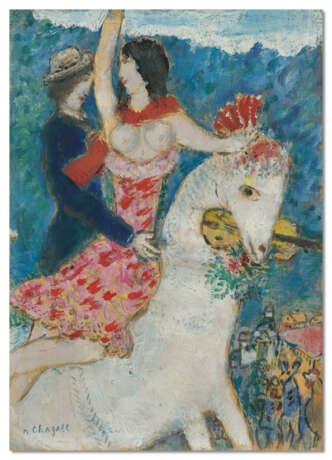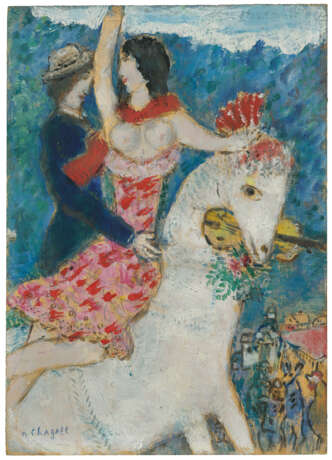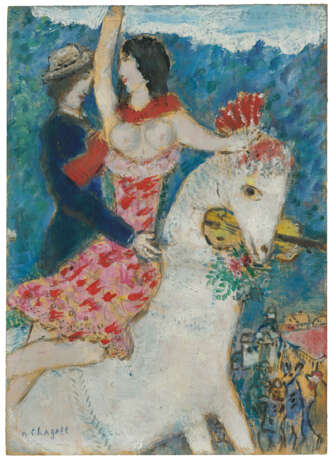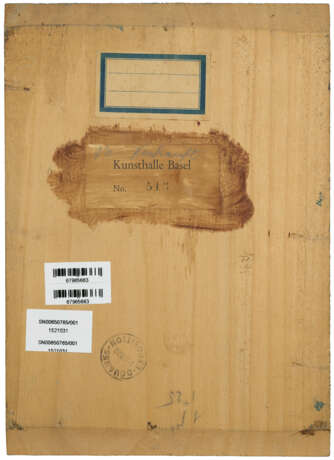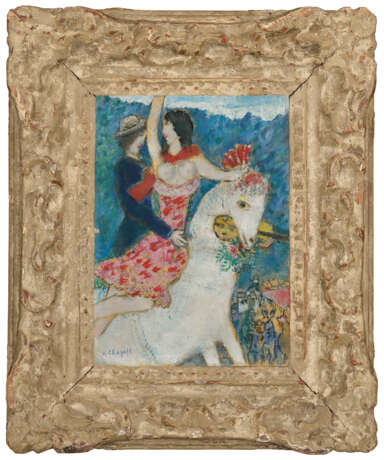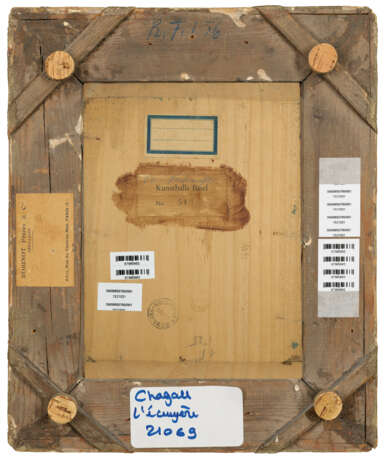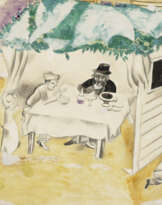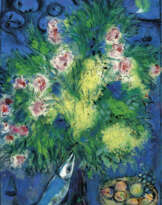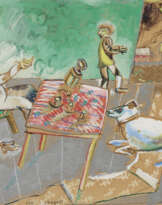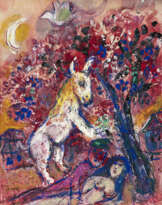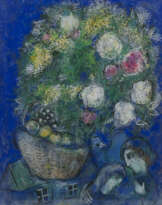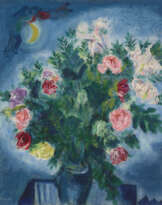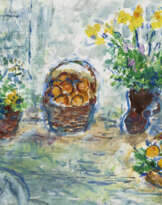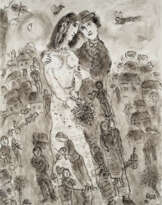ID 832045
Лот 51 | Marc Chagall (1887-1985)
Оценочная стоимость
€ 300 000 – 500 000
L'Écuyère
signé 'M. ChAgAll' (en bas à gauche)
huile et graphite sur panneau
22 x 15.8 cm.
Peint en 1932-33
signed 'M. ChAgAll' (lower left)
oil and pencil on panel
8 5/8 x 6 1/4 in.
Painted in 1932-33
Provenance
Collection particulière, Suisse (acquis auprès de l'artiste par l'intermédiaire de la Kunsthalle, Bâle entre novembre 1933 et janvier 1934).
Puis par descendance au propriétaire actuel.
Exhibited
Bâle, Kunsthalle Basel, Marc Chagall, novembre-décembre 1933, p. 17, no. 92.
Special notice
Artist's Resale Right ("droit de Suite").
If the Artist's Resale Right Regulations 2006 apply to this lot, the buyer also agrees to pay us an amount equal to the resale royalty provided for in those Regulations, and we undertake to the buyer to pay such amount to the artist's collection agent.
ƒ: In addition to the regular Buyer’s premium, a commission of 5.5%
inclusive of VAT of the hammer price will be charged to the buyer.
It will be refunded to the Buyer upon proof of export of the lot
outside the European Union within the legal time limit.
(Please refer to section VAT refunds)
Post lot text
Conçu vers 1932-33, ce petit chef-d'œuvre aux couleurs éclatantes est une version très spontanée de l’Équestrienne de 1931, toile magistrale de Chagall actuellement abritée par le Stedelijk Museum d'Amsterdam. Il y a quelques mois, Christie's Paris vendait pour plus d'un million d'euros une gouache préparatoire de ce même tableau – également intitulée L'Écuyère, mais datée de 1931. À l'instar des deux variantes de 1931, la présente cavalière de 1932-33 aux dimensions plus modestes rassemble dans une même composition des leitmotivs chers à Chagall, notamment les amants, le cheval volant, le cirque, le violon et le coq. Dans ces trois tableaux peints à l'apogée de sa carrière, on retrouve aussi les deux grands amours de l'artiste : Bella Rosenfeld, sa compagne de jeunesse, et Vitebsk, sa ville natale en Russie. Entraînés dans le bleu vaporeux du ciel par un majestueux étalon blanc, les amants enlacés évoquent ici toute la tendresse et toute la dévotion qui sous-tendait l'union entre Chagall et Bella.
Chagall rencontre Bella Rosenfeld peu de temps avant de rejoindre la France pour la première fois à l'été 1910 ; ils seront fiancés dans l'année. Durant les quatre ans qui s'ensuivent, le couple s'écrit régulièrement et le peintre, installé à Paris, souffre d'un mal du pays intensifié par le désir de retrouver sa lointaine fiancée. Profitant d'un voyage à Berlin à la mi-1914 à l'occasion d'une exposition de ses œuvres, Chagall se rend à Vitebsk pour un séjour qui ne doit, à l'origine, durer que trois mois ; or le déclenchement de la Grande Guerre, suivi de la Révolution russe, finissent par le retenir sur ses terres natales pendant près de dix ans. Cette longue parenthèse slave s'avère déterminante pour le peintre. Il épouse Bella en 1915, quelques mois seulement après son retour à Vitebsk ; leur fille unique, Ida, voit le jour l'année suivante. Aussi, durant ce temps où l'artiste se partage entre Vitebsk et Petrograd (Saint-Pétersbourg), sa peinture ne cesse de connaître de remarquables transformations.
La présente œuvre date de la deuxième période de Chagall en France, où il retourne en 1923 pour y résider jusqu'à son départ pour les États-Unis en 1941, dans le branle-bas de la guerre mondiale. Cette seconde étape française s'avère particulièrement heureuse et, par conséquent, féconde. Après neuf ans d'absence, le peintre trouve à Paris un nouvel équilibre, une atmosphère paisible et un public inédit. Si ses anciens amis étaient nombreux à le croire disparu dans les tumultes de la Révolution russe (son atelier a d'ailleurs été considérablement pillé en conséquence), ils sont également nombreux à se réjouir de son retour. Les surréalistes lui réservent notamment un accueil enthousiaste et Chagall est, pour sa part, agréablement surpris de les voir prôner un nouveau genre de peinture onirique, dans le sillage de l'art plein de poésie qu'il avait lui-même initié quelques années plus tôt.
À cette époque, l'œuvre de Chagall alterne entre des motifs inspirés de sa France adoptive et des sujets qui font allusion à sa patrie natale. C'est alors que les amants flottant dans les airs s'imposent durablement comme l'un des thèmes les plus emblématiques de son art. En 1931, Chagall a déjà reçu plusieurs commandes d'envergure, parmi lesquelles le décor du théâtre juif de Moscou en 1920 et la conception de costumes pour différents ballets. Entre 1925 et 1927, il réalise par ailleurs à la demande de l'influent marchand d'art Ambroise Vollard (1866-1939) une série de gouaches illustrant les Fables de La Fontaine, dont le succès pousse le mécène à lui confier sans tarder un autre projet ambitieux, le Cirque Vollard, constitué de dix-neuf gouaches consacrées au monde du cirque. En 1931, c'est encore à l'initiative de Vollard que Chagall illustre la Bible, tâche gargantuesque que l'artiste accomplit brillamment au lendemain d'un voyage en famille à Tel-Aviv, suivi d'une expédition bouleversante de plusieurs mois à travers la Palestine.
Lorsqu'il peint la présente amazone aux alentours de 1932-33, Chagall a donc déjà pleinement affirmé son style singulier. Grâce aux trois importantes commandes de Vollard, il a notamment démontré sa virtuosité d'illustrateur dans des registres aussi variés que le fantastique, la mythologie, les scènes religieuses ou le cirque. Autant d'œuvres saisissantes qui lui ont permis de déployer toutes les facettes de son monde imaginaire, au service d'un lexique visuel extrêmement intime et poétique. Malgré ses dimensions réduites, ce panneau constitue sans doute la version la plus dynamique et la plus vibrante de l'écuyère de Chagall, rendue ici par de riches contrastes de couleurs, une nuée de détails et un geste d'une grande spontanéité.
Executed circa 1932-33, this jewel-like panel, with its explosion of colors, is a smaller and more spontaneous version of Chagall’s famous masterpiece the Équestrienne of 1931, today housed in the Stedelijk Museum, in Amsterdam. A few months ago, Christie’s Paris sold for over a million euros a preparatory gouache drawing – also titled L’écuyère yet dated 1931 - for the same painting. Painted at the peak of the artist’s career, L'Écuyère of 1932-33 and the two aforementioned versions of 1931, reunite into one artwork several leitmotivs of Chagall’s whimsical world – the lovers, the flying horse, the circus, the violin, the rooster - and the loves of his life, his childhood sweetheart Bella Rosenfeld and Vitebsk, the artist’s Russian homeland. Entwined together in a dreamy blue sky, swept along by a regal white stallion, the lovers emblematize the profound devotion and tenderness so present in Chagall and Bella’s relationship. Shortly before his first departure from Russia in the summer of 1910, Chagall met Bella Rosenfeld; they would be engaged within a year. During his ensuing four years in Paris, they corresponded frequently and his homesickness for Russia was enmeshed in his desire for his distant fiancée. After travelling to Berlin in mid-1914 for an exhibition of his works, Chagall travelled on to Vitebsk for what was to be a three-month visit, however the outbreak of World War I and the ensuing revolution in Russia would keep Chagall away from Paris for almost a decade. While unable to leave Russia, these years would prove to be some of the most important of Chagall’s life. Shortly after his return to Vitebsk, he and Bella would marry in 1915 and, a year later, their only child, a daughter named Ida, was born. Moving primarily between Vitebesk and Petrograd (St. Petersburg) during these years, Chagall’s painting would continue to undergo remarkable transformations.
The present work was executed during Chagall’s second period in France, where he returned in 1923 and remained until his move to the United States in 1941 during the Second World War. These years in France were particularly joyful and consequently fruitful for Chagall. Having been absent for nine years, when he returned to Paris he found a new equilibrium of mind, a peaceful atmosphere and an audience. Many of his former friends believed he had disappeared in the Russian Revolution (his old studio was badly looted as a result). Among those welcoming him back were the young Surrealists, and Chagall in turn was pleasantly surprised to find that they stood for a changing attitude towards the sort of dream-like poetic painting he had pioneered many years before.
During Chagall’s years in France, his subjects were divided between those inspired by his adopted country and those reminiscent of his native Russia. It was during these years that the couple in flight – a trope that would become recognized as one of the artist’s prime pictorial devices in later years - became firmly established. By 1931, Chagall had achieved several major commissions, including , the decoration of the Jewish Theatre in Moscow in 1920, as well as the production of many costume designs for various ballets. In addition, the highly influential art dealer Ambroise Vollard (1866-1939) had sponsored Chagall’s Fables de la Fontaine gouache illustrations, executed between 1925 and 1927, the success of which almost immediately led him to commission the Vitebsk-born artist another ambitious project, that of the Cirque Vollard comprising of 19 gouaches illustrating the circus world. Finally, Vollard challenged Chagall with the gargantuan task of illustrating the Bible in 1931, which the artist brilliantly achieved having been heavily affected by his trip to Tel Aviv with his family that same year, and extending his trip throughout the Holy Land for two months.
Therefore, when Chagall realized the present Écuyère around 1932-33, he had successfully asserted his own personal style in his three Vollard commissions, he had mastered the illustration of fantastical, mythical and spiritual realms as well as that of the circus world, and he had fully deployed all the facets of his imagination, enabling him to create such fascinating artworks with a very unique and poetic visual lexicon. Although this panel is the smallest of the three versions of the same subject, it is definitively the most dynamic and lively composition, rendered through its rich color contrasts and patterns, and its gestural and spontaneous execution.
| Автор: | Марк Захарович Шагал (1887 - 1985) |
|---|---|
| Техника исполнения: | Масло на панели |
| Категория аукционного дома: | Картины |
| Автор: | Марк Захарович Шагал (1887 - 1985) |
|---|---|
| Техника исполнения: | Масло на панели |
| Категория аукционного дома: | Картины |
| Адрес торгов |
CHRISTIE'S 8 King Street, St. James's SW1Y 6QT London Великобритания | |
|---|---|---|
| Предосмотр |
| |
| Телефон | +44 (0)20 7839 9060 | |
| Комиссия | see on Website | |
| Условия использования | Условия использования |
